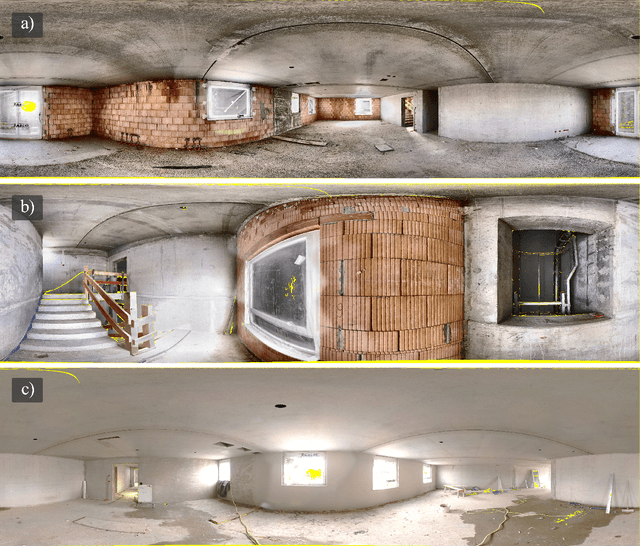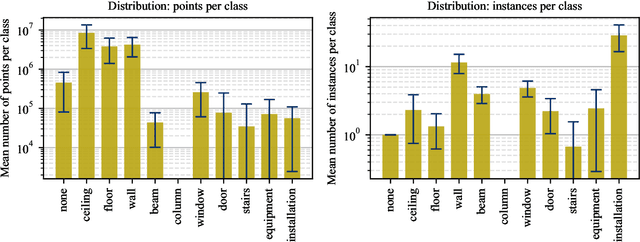Lukas Rauch
Can Masked Autoencoders Also Listen to Birds?
Apr 17, 2025Abstract:Masked Autoencoders (MAEs) pretrained on AudioSet fail to capture the fine-grained acoustic characteristics of specialized domains such as bioacoustic monitoring. Bird sound classification is critical for assessing environmental health, yet general-purpose models inadequately address its unique acoustic challenges. To address this, we introduce Bird-MAE, a domain-specialized MAE pretrained on the large-scale BirdSet dataset. We explore adjustments to pretraining, fine-tuning and utilizing frozen representations. Bird-MAE achieves state-of-the-art results across all BirdSet downstream tasks, substantially improving multi-label classification performance compared to the general-purpose Audio-MAE baseline. Additionally, we propose prototypical probing, a parameter-efficient method for leveraging MAEs' frozen representations. Bird-MAE's prototypical probes outperform linear probing by up to 37\% in MAP and narrow the gap to fine-tuning to approximately 3\% on average on BirdSet.
Multi-dataset synergistic in supervised learning to pre-label structural components in point clouds from shell construction scenes
Feb 20, 2025



Abstract:The significant effort required to annotate data for new training datasets hinders computer vision research and machine learning in the construction industry. This work explores adapting standard datasets and the latest transformer model architectures for point cloud semantic segmentation in the context of shell construction sites. Unlike common approaches focused on object segmentation of building interiors and furniture, this study addressed the challenges of segmenting complex structural components in Architecture, Engineering, and Construction (AEC). We establish a baseline through supervised training and a custom validation dataset, evaluate the cross-domain inference with large-scale indoor datasets, and utilize transfer learning to maximize segmentation performance with minimal new data. The findings indicate that with minimal fine-tuning, pre-trained transformer architectures offer an effective strategy for building component segmentation. Our results are promising for automating the annotation of new, previously unseen data when creating larger training resources and for the segmentation of frequently recurring objects.
dopanim: A Dataset of Doppelganger Animals with Noisy Annotations from Multiple Humans
Jul 30, 2024Abstract:Human annotators typically provide annotated data for training machine learning models, such as neural networks. Yet, human annotations are subject to noise, impairing generalization performances. Methodological research on approaches counteracting noisy annotations requires corresponding datasets for a meaningful empirical evaluation. Consequently, we introduce a novel benchmark dataset, dopanim, consisting of about 15,750 animal images of 15 classes with ground truth labels. For approximately 10,500 of these images, 20 humans provided over 52,000 annotations with an accuracy of circa 67%. Its key attributes include (1) the challenging task of classifying doppelganger animals, (2) human-estimated likelihoods as annotations, and (3) annotator metadata. We benchmark well-known multi-annotator learning approaches using seven variants of this dataset and outline further evaluation use cases such as learning beyond hard class labels and active learning. Our dataset and a comprehensive codebase are publicly available to emulate the data collection process and to reproduce all empirical results.
Towards Deep Active Learning in Avian Bioacoustics
Jun 26, 2024

Abstract:Passive acoustic monitoring (PAM) in avian bioacoustics enables cost-effective and extensive data collection with minimal disruption to natural habitats. Despite advancements in computational avian bioacoustics, deep learning models continue to encounter challenges in adapting to diverse environments in practical PAM scenarios. This is primarily due to the scarcity of annotations, which requires labor-intensive efforts from human experts. Active learning (AL) reduces annotation cost and speed ups adaption to diverse scenarios by querying the most informative instances for labeling. This paper outlines a deep AL approach, introduces key challenges, and conducts a small-scale pilot study.
Fast Fishing: Approximating BAIT for Efficient and Scalable Deep Active Image Classification
Apr 13, 2024



Abstract:Deep active learning (AL) seeks to minimize the annotation costs for training deep neural networks. BAIT, a recently proposed AL strategy based on the Fisher Information, has demonstrated impressive performance across various datasets. However, BAIT's high computational and memory requirements hinder its applicability on large-scale classification tasks, resulting in current research neglecting BAIT in their evaluation. This paper introduces two methods to enhance BAIT's computational efficiency and scalability. Notably, we significantly reduce its time complexity by approximating the Fisher Information. In particular, we adapt the original formulation by i) taking the expectation over the most probable classes, and ii) constructing a binary classification task, leading to an alternative likelihood for gradient computations. Consequently, this allows the efficient use of BAIT on large-scale datasets, including ImageNet. Our unified and comprehensive evaluation across a variety of datasets demonstrates that our approximations achieve strong performance with considerably reduced time complexity. Furthermore, we provide an extensive open-source toolbox that implements recent state-of-the-art AL strategies, available at https://github.com/dhuseljic/dal-toolbox.
BirdSet: A Multi-Task Benchmark for Classification in Avian Bioacoustics
Mar 15, 2024Abstract:Deep learning (DL) models have emerged as a powerful tool in avian bioacoustics to diagnose environmental health and biodiversity. However, inconsistencies in research pose notable challenges hindering progress in this domain. Reliable DL models need to analyze bird calls flexibly across various species and environments to fully harness the potential of bioacoustics in a cost-effective passive acoustic monitoring scenario. Data fragmentation and opacity across studies complicate a comprehensive evaluation of general model performance. To overcome these challenges, we present the BirdSet benchmark, a unified framework consolidating research efforts with a holistic approach for classifying bird vocalizations in avian bioacoustics. BirdSet harmonizes open-source bird recordings into a curated dataset collection. This unified approach provides an in-depth understanding of model performance and identifies potential shortcomings across different tasks. By establishing baseline results of current models, BirdSet aims to facilitate comparability, guide subsequent data collection, and increase accessibility for newcomers to avian bioacoustics.
Active Bird2Vec: Towards End-to-End Bird Sound Monitoring with Transformers
Aug 14, 2023Abstract:We propose a shift towards end-to-end learning in bird sound monitoring by combining self-supervised (SSL) and deep active learning (DAL). Leveraging transformer models, we aim to bypass traditional spectrogram conversions, enabling direct raw audio processing. ActiveBird2Vec is set to generate high-quality bird sound representations through SSL, potentially accelerating the assessment of environmental changes and decision-making processes for wind farms. Additionally, we seek to utilize the wide variety of bird vocalizations through DAL, reducing the reliance on extensively labeled datasets by human experts. We plan to curate a comprehensive set of tasks through Huggingface Datasets, enhancing future comparability and reproducibility of bioacoustic research. A comparative analysis between various transformer models will be conducted to evaluate their proficiency in bird sound recognition tasks. We aim to accelerate the progression of avian bioacoustic research and contribute to more effective conservation strategies.
DADO -- Low-Cost Selection Strategies for Deep Active Design Optimization
Jul 10, 2023Abstract:In this experience report, we apply deep active learning to the field of design optimization to reduce the number of computationally expensive numerical simulations. We are interested in optimizing the design of structural components, where the shape is described by a set of parameters. If we can predict the performance based on these parameters and consider only the promising candidates for simulation, there is an enormous potential for saving computing power. We present two selection strategies for self-optimization to reduce the computational cost in multi-objective design optimization problems. Our proposed methodology provides an intuitive approach that is easy to apply, offers significant improvements over random sampling, and circumvents the need for uncertainty estimation. We evaluate our strategies on a large dataset from the domain of fluid dynamics and introduce two new evaluation metrics to determine the model's performance. Findings from our evaluation highlights the effectiveness of our selection strategies in accelerating design optimization. We believe that the introduced method is easily transferable to other self-optimization problems.
ActiveGLAE: A Benchmark for Deep Active Learning with Transformers
Jun 16, 2023Abstract:Deep active learning (DAL) seeks to reduce annotation costs by enabling the model to actively query instance annotations from which it expects to learn the most. Despite extensive research, there is currently no standardized evaluation protocol for transformer-based language models in the field of DAL. Diverse experimental settings lead to difficulties in comparing research and deriving recommendations for practitioners. To tackle this challenge, we propose the ActiveGLAE benchmark, a comprehensive collection of data sets and evaluation guidelines for assessing DAL. Our benchmark aims to facilitate and streamline the evaluation process of novel DAL strategies. Additionally, we provide an extensive overview of current practice in DAL with transformer-based language models. We identify three key challenges - data set selection, model training, and DAL settings - that pose difficulties in comparing query strategies. We establish baseline results through an extensive set of experiments as a reference point for evaluating future work. Based on our findings, we provide guidelines for researchers and practitioners.
 Add to Chrome
Add to Chrome Add to Firefox
Add to Firefox Add to Edge
Add to Edge